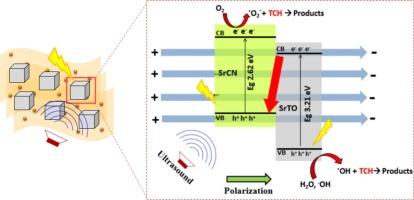Constructing a heterojunction of Sr-doped g-C3N4 decorated with SrTiO3 for advanced piezo/photo catalytic degradation of TCH antibiotic
IF 4.7
3区 化学
Q2 CHEMISTRY, PHYSICAL
Journal of Photochemistry and Photobiology A-chemistry
Pub Date : 2025-08-29
DOI:10.1016/j.jphotochem.2025.116718
引用次数: 0
Abstract
Piezo-assisted photocatalysis has developed as an integrated process for organic pollutants degradation by supporting the photocarriers separation through the piezoelectric polarization effect. Herein, we constructed SrTiO3-decorated Sr-doped g-C3N4 (SrTO/SrCN) heterojunction catalysts with different SrTO weight ratios (from 5 to 50 wt%) to obtain effective piezo/photo-catalysts for decomposition of tetracycline hydrochloride antibiotic (TCH) under visible light and ultrasonic circumstances. The band gap reduction of SrCN resulting from Sr doping, the fabrication of the Z-system heterojunction between SrTO and SrCN, which successfully reduces the charge recombination of photocarriers, and the piezoelectric polarization effects of SrTO contributed to the enhancement of the piezo/photo-catalytic TCH degradation. Noticeably, the degradation reached 98.3 in 50 min over 30 wt%-SrTO/SrCN heterojunction catalyst, which was higher than that of the pur SrTO, CN, and SrCN samples. Furthermore, The TOC removal of TCH reached 83.5 %, indicating outstanding mineralization performance of SrTO/SrCN sample. Through the trapping study, O2− and •OH species played a pivotal role in the TCH decomposition process, which supports the proposed mechanism in this work. Besides, excellent durability of SrTO/SrCN heterojunction piezo/photo-catalysts has been detected, in which 92.7 % TCH decomposition was still obtained after five recycled processes.

构建SrTiO3修饰的sr掺杂g-C3N4异质结用于先进的压电/光催化降解TCH抗生素
压电辅助光催化是一种利用压电极化效应支持光载流子分离的有机污染物降解的综合工艺。本文构建了srtio3修饰的SrTO掺杂g-C3N4 (SrTO/SrCN)异质结催化剂,不同SrTO重量比(5 ~ 50 wt%)制备了有效的压电/光催化剂,用于在可见光和超声条件下分解盐酸四环素抗生素(TCH)。Sr掺杂导致SrCN的带隙减小,SrTO与SrCN之间的z系异质结的制备成功地减少了光载流子的电荷重组,SrTO的压电极化效应有助于增强压电/光催化TCH降解。值得注意的是,在30 wt%-SrTO/SrCN异质结催化剂上,50 min的降解率达到98.3,高于纯SrTO、CN和SrCN样品。此外,对TCH的TOC去除率达到83.5%,表明SrTO/SrCN样品具有良好的矿化性能。通过捕获研究,O2−和•OH在TCH分解过程中发挥了关键作用,支持了本文提出的机制。此外,SrTO/SrCN异质结压电/光催化剂具有优异的耐久性,经过5次循环后,其TCH分解率仍达到92.7%。
本文章由计算机程序翻译,如有差异,请以英文原文为准。
求助全文
约1分钟内获得全文
求助全文
来源期刊
CiteScore
7.90
自引率
7.00%
发文量
580
审稿时长
48 days
期刊介绍:
JPPA publishes the results of fundamental studies on all aspects of chemical phenomena induced by interactions between light and molecules/matter of all kinds.
All systems capable of being described at the molecular or integrated multimolecular level are appropriate for the journal. This includes all molecular chemical species as well as biomolecular, supramolecular, polymer and other macromolecular systems, as well as solid state photochemistry. In addition, the journal publishes studies of semiconductor and other photoactive organic and inorganic materials, photocatalysis (organic, inorganic, supramolecular and superconductor).
The scope includes condensed and gas phase photochemistry, as well as synchrotron radiation chemistry. A broad range of processes and techniques in photochemistry are covered such as light induced energy, electron and proton transfer; nonlinear photochemical behavior; mechanistic investigation of photochemical reactions and identification of the products of photochemical reactions; quantum yield determinations and measurements of rate constants for primary and secondary photochemical processes; steady-state and time-resolved emission, ultrafast spectroscopic methods, single molecule spectroscopy, time resolved X-ray diffraction, luminescence microscopy, and scattering spectroscopy applied to photochemistry. Papers in emerging and applied areas such as luminescent sensors, electroluminescence, solar energy conversion, atmospheric photochemistry, environmental remediation, and related photocatalytic chemistry are also welcome.

 求助内容:
求助内容: 应助结果提醒方式:
应助结果提醒方式:


